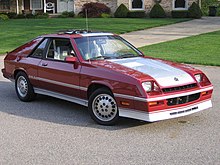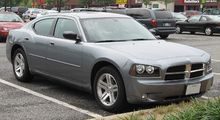Dodge Charger
This article includes a list of general references, but it remains largely unverified because it lacks sufficient corresponding inline citations. (December 2015) |
| Dodge Charger | |
|---|---|
 | |
| Overview | |
| Manufacturer | Dodge |
| Production |
|
| Model years |
|
The Dodge Charger is a model of automobile marketed by Dodge in various forms over seven generations between 1966 and today.
The first Charger was a show car in 1964.[1][2] A 1965 Charger II concept car had a remarkable resemblance to the 1966 production version.[3]
The Charger has been built on three different platforms in various sizes. In the United States, the Charger nameplate has been used on subcompact hatchbacks, full-size sedans, muscle cars, and personal luxury coupes. The current version is a four-door sedan.
Background[]
The 1966 Charger was an effort by Dodge to produce an upscale, upsized pony car. American Motors had already built a very similar vehicle in 1965, the Marlin, which was positioned as a personal car, an emerging market niche.
Mercury was more successful in its execution in introducing the upscale Cougar, which was both considerably larger and more refined than the Ford Mustang that pioneered the pony car concept in 1964 - yet still had badly compromised rear seating.
The Charger was intended to up the ante to an even more expensive and luxurious coupe that featured all-bucket seating for four.
First generation: 1966–1967[]


The Charger was introduced during the 1966 model year. It featured a two-door fastback body design and a four bucket seat interior. The intermediate-sized Charger shared components with the Coronet that also used the Chrysler B platform. The base engine was a 318 cu in (5.2 L) V8 with a three-speed manual and an optional automatic transmission. Larger and more powerful engines were also available such as the 426 cubic inch Hemi V8. Sales were low.
Second generation: 1968–1970[]


The Charger was redesigned for 1968, and an initial 35,000 units were slated for production. The demand was high and 96,100 Chargers were actually produced.[4] Based on the Chrysler B platform, the model years received various cosmetic changes to the exterior and interior including: an undivided grill, rounded tail lights, and hidden headlights. The powertrains were carried over from 1967, but the 225 cu in (3.7 L) slant-6 became available in mid-1968.[5] The Charger was not successful in stock car racing such as NASCAR. A more aerodynamic shape formed the Charger 500 model that became the basis for the 1969 Charger Daytona.
Third generation: 1971–1974[]


The third generation Charger was introduced for the 1971 model year. Chrysler's B platform was modified to meet new emissions and safety regulations. Available in six different packages with cosmetic changes that include: a split grill, semi fastback rear window, and a ducktail spoiler. The 1973 and 1974 Chargers were similar to the 1971, with minor differences in the grille and headlamps. 1973 and 1974 Chargers also wore new quarter windows, which were larger and shaped differently than the quarter windows seen on 1971 and 1972 models. The increase in sales was primarily due to the elimination of the Dodge Coronet, which meant Dodge offered the two-door intermediate-size body style only as of the Charger.
The name Charger was also used in Brazil as a performance model based on the Dart (A-Body) (1971–80).
Fourth generation: 1975–1978[]

The 1975 model year Charger continued as a B body car and was restyled in an effort by Dodge to move the model into the growing personal luxury car market segment. In 1978 Dodge added the Magnum to that segment. A Daytona model fourth-generation Charger featured stripes that ran along the length of the car.
Fifth generation: 1982–1987[]

The Charger returned in 1981½ as a front-wheel drive subcompact hatchback coupe, available with a five-speed manual or three-speed automatic transmission. This economy-type model was similar to the Dodge Omni 024, but slightly larger. The Charger was available with a 2.2 L SOHC engine or a turbocharged 2.2 L SOHC. The turbo was available only with the manual transmission, unlike in the Dodge Daytona. A Shelby Charger was offered starting in 1983, with a turbo version available in 1984 producing 142 hp (106 kW; 144 PS) @ 5600 rpm and 160 pound force-feet (220 N⋅m) of torque @ 3200 rpm. The engine was not intercooled and used a small t3 Garrett turbo. In 1985, the electronics were updated, but the power output was the same. In 1986, the electronics were further updated.
Sixth generation: 2006–2010 (LX)[]


After a 20 year absence, Dodge reintroduced the Charger in 2005 for the 2006 model year [6] as a Chrysler LX platform-based four-door sedan. It shared little with the 1999 Charger concept car.
Initially, the Charger was available in SE, SXT, R/T, R/T with Road/Track Performance Group, Police, and Daytona R/T versions. For the first time, a V6 engine was available, as was all-wheel drive (AWD). All-wheel drive was first only available on the R/T package. However, from 2009 onwards, all-wheel drive was also an option for the SE and SXT versions.[7]
The basic SE model included a 2.7 L V6 engine, 5-speed automatic transmission with "AutoStick" manual shifting feature, 17-inch wheels, air conditioning, all-speed traction control, as well as ABS and electronic stability control, a CD player, tilt and telescoping steering column, power locks/mirrors/windows, and remote keyless entry. Additional features and trims were available, including the Charger R/T with a 5.7 L Hemi V8 mated to a 5-speed automatic transmission. A multiple-displacement system that allowed it to save fuel by running on only four cylinders when cruising was also featured in the V8.
Performance was the focus of the Charger SRT8 equipped with a 6.1 L Hemi engine mated to a 5-speed automatic, as well as conveniences such as an eight-way power front passenger seat, automatic climate control, unique grille and rear spoiler, body-color interior trim, special front fascia and engine cover, larger exhaust tips, performance steering gear, heated front seats with perforated suede inserts, power-adjustable pedals, and unique colors and exterior trim. An optional Road/Track package offered ten additional horsepower, a GPS navigation system, a 322-watt audio system, a sunroof, and a rear-seat DVD entertainment system and radio.
Seventh generation (LD): 2011–present[]

The Charger received an improved interior and new exterior styling for 2011. This included new side scoops along both front and rear doors, more angular headlights, aggressive new grille styling, and a more defined and aerodynamic shape overall. Most notably, the back end adopted a more modern wrap-around LED tail light spanning nearly the entire width of the trunk. Driver visibility was improved by more than 15%, addressing complaints from previous years. The side and rear styling cues are reminiscent of the 1968-1970 models.
Base performance was increased, with the 3.5 L 250 hp (186 kW; 253 PS) V6 engine replaced with a Pentastar 3.6 L producing 292 hp (218 kW; 296 PS) @ 6350 rpm and 260 pound force-feet (350 N⋅m) of torque @ 4800 rpm. The 4-speed automatic transmission was replaced with the 5-speed A580 auto.[8][9]
The SRT-8 was not produced for the 2011 model year.
The 2012 year brought a new 8-speed automatic transmission to the V6 model. This year also saw the return of the SRT-8 to the model lineup. AWD was also added to the V6, making AWD available on all but the SRT-8 model.

For the 2012 – 2018 years, the Super Bee platform (Later called Scat Pack 15+) was available, using features seen in regular SRT-8 models with accessories and badges reminiscent of the 60s and 70s muscle car. These included a 6.4 L engine rated at 470 hp (350 kW; 477 PS) and had four-piston Brembo calipers, slotted rotors, paddle shifters, SRT launch features (such as 0-60 timing, Live G-Force readings, and ¼ and ⅛ mile drag timers), custom seat embroidery as well as other features.
The 2014 Pursuit model no longer included chrome exhaust tip extensions, as they often scraped during maneuvers over medians.
For 2015, the Charger received significant exterior styling updates. Most notably, the new front end featured new LED lights and a more aerodynamic nose that was less angled and featured a noticeable curve around the headlight housing. Suspensions, interior, and brakes were also redesigned.
The 2017 model had an upgrade to the 8.4-inch navigation/display system and was restyled due to issues with the previous system.
Except for Charger Pursuit (through 2019), all models came standard with the eight-speed automatic transmission. In January 2014, the AWD Charger Pursuit appeared, and the V8 R/T AWD model disappeared. Sales of the AWD Pursuit increased.
For 2020, the Charger Hellcat comes standard with the "widebody" to accommodate an improved tire/suspension package. Dodge also added a new trim for 2020 called the SRT Hellcat Redeye. The Hellcat Redeye comes standard with the 797 hp (594 kW; 808 PS) V8 engine.[10] The 2020 Charger Pursuit is only available in the RWD V6 and AWD V8 models, with the RWD V8 model being discontinued. Both Pursuit models now feature eight-speed automatic transmissions.
Other models[]
- Dodge Charger Daytona – the name given to three different modified Dodge Chargers built on the B-body and LX platforms
- Dodge Super Bee
- Shelby Charger
- Dodge Charger R/T (1999 concept)
See also[]
- 1971–1976 Chrysler Valiant Charger – short wheelbase Valiant coupe produced by Chrysler Australia
- The General Lee – Dodge Charger used in the television series The Dukes of Hazzard
- Dodge Challenger – a 1970s muscle car, revived in the 2000s
References[]
- ^ "1964 Dodge Hemi Charger Concept Car". Supercars.net. April 15, 2016. Retrieved October 10, 2019.
- ^ Auto Editors of Consumer Guide (August 20, 2007). "1964 Dodge Charger". HowStuffWorks.com. Retrieved October 10, 2019.
- ^ Ernst, Kurt (December 16, 2015). "The (original) Dodge Charger marks its golden anniversary". Hemmings. Retrieved October 10, 2019.
- ^ "Vehicle Profile: 1968 Dodge Charger". The ClassicCars.com Journal. Retrieved November 21, 2018.
- ^ Palmer, Jamie (May 2, 2019). "One Of 906! 1968 Slant-Six Dodge Charger". Barn Finds. Retrieved July 7, 2020.
- ^ "Dodge Charger History - Sixth Generation: 2006 to Present". Edmunds. Retrieved October 6, 2015.
- ^ "Is The Dodge Charger AWD, RWD, Or FWD? (Explained)". thedriveradviser.com. The Driver Adviser. Retrieved September 18, 2021.
- ^ "All-new 3.6-litre V-6 Technical Specifications". Chrysler. June 20, 2010. Retrieved August 29, 2010.
- ^ "3.6-litre V-6 General Specifications" (PDF). Chrysler. February 15, 2011. Archived from the original (PDF) on July 8, 2011. Retrieved February 15, 2011.
- ^ Niebuhr, Kurt (October 14, 2020). "2021 Dodge Charger Prices, Reviews, and Pictures". Edmunds.com.
External links[]
- Official current production website
- Dodge Charger at Curlie
- A history of the pre-2000s Dodge Charger
- A history of Dodge Chargers by Edmunds.com
- A 1981 review of the Dodge Charger by CarandDriver.com
| show |
|---|
- Set indices on cars
- Dodge vehicles